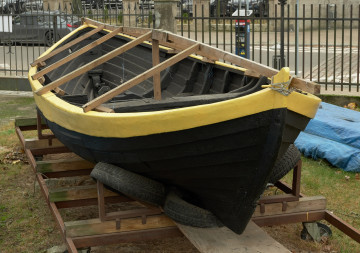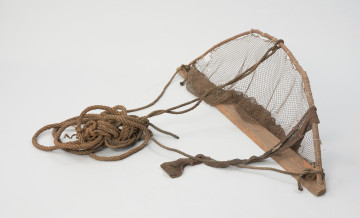
Fishing boat
1. połowa XX wieku
National Museum in Szczecin
Part of the collection: Traditional fishing
A yoke was an accessory used when fishing with seines – large and heavy nets. It consisted of a sackcloth belt, a wooden pole and a short rope ending in a knob. The fisherman would fasten the belt around his waist, hold the pole in front of him and attach the knob to the rope of the seine’s wing. He moved backwards. After pulling out a section of the net, he would unhook the knob, move closer to the shore and repeat the operation until the whole seine was pulled out of the water. The advantage of using the yoke was that during the work the strength of the whole body was used, not just the arms. The whole families of the fishermen, including older children, worked at towing the seine. A set of three yokes in the collection of the Department of the Ethnography of the Pomerania of the National Museum in Szczecin comes from the turn of the 19th and 20th centuries, from the Baltic town of Niechorze. Two of them are marked with the same merk, the owner's mark consisting of a combination of lines. The seine was the property of the maszoperia which was a group of fishermen working together, while the small tools and accessories, such as yokes, were owned by individual fishermen. The use of merks was widespread, each family had its own, inherited from generation to generation.
Agnieszka Słowińska
Author / creator
Dimensions
cały obiekt:
Creation time / dating
Identification number
Location / status

1. połowa XX wieku
National Museum in Szczecin

1. połowa XX wieku
National Museum in Szczecin

1. połowa XX wieku
National Museum in Szczecin
DISCOVER this TOPIC
National Museum in Lublin
DISCOVER this PATH
Educational path